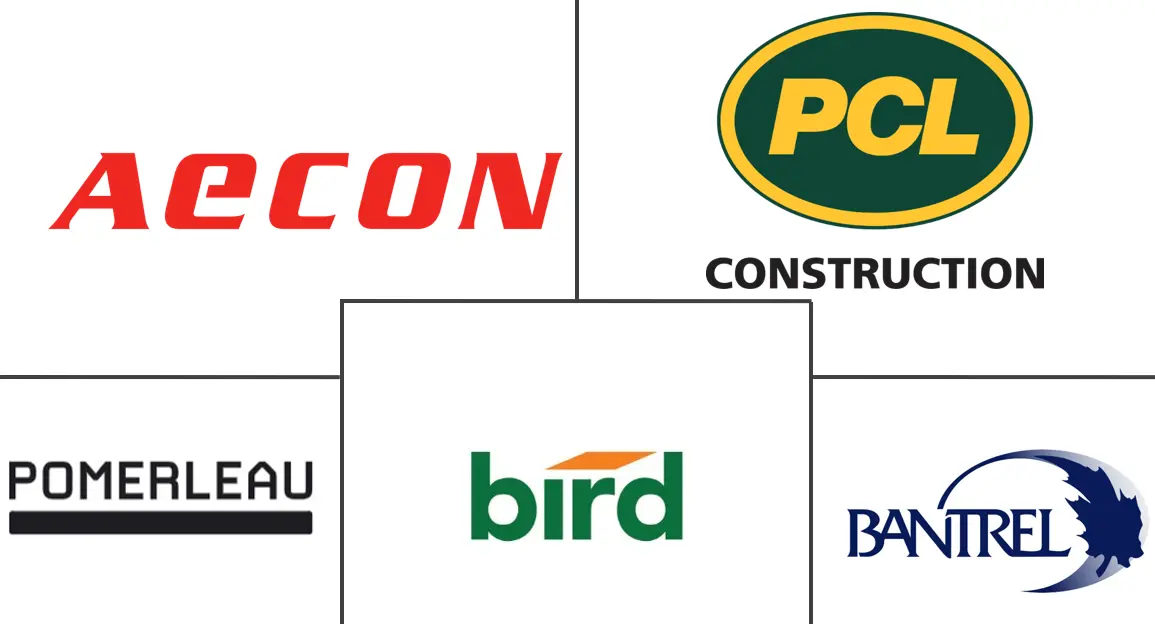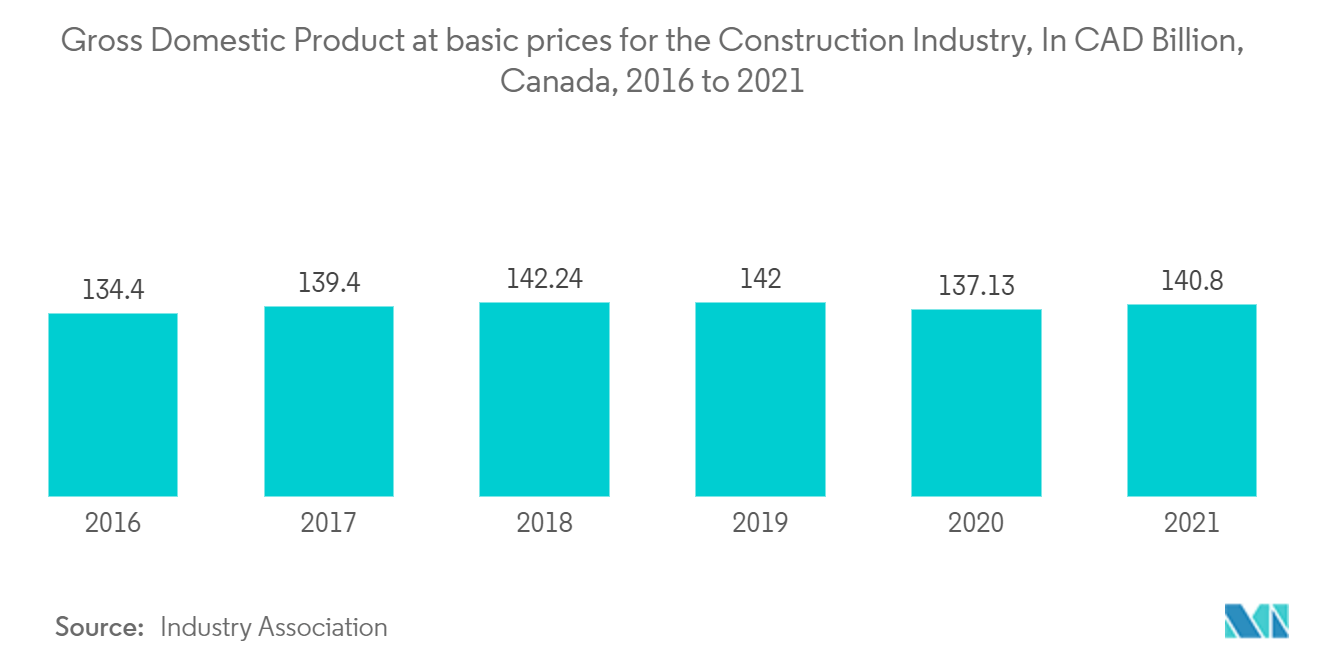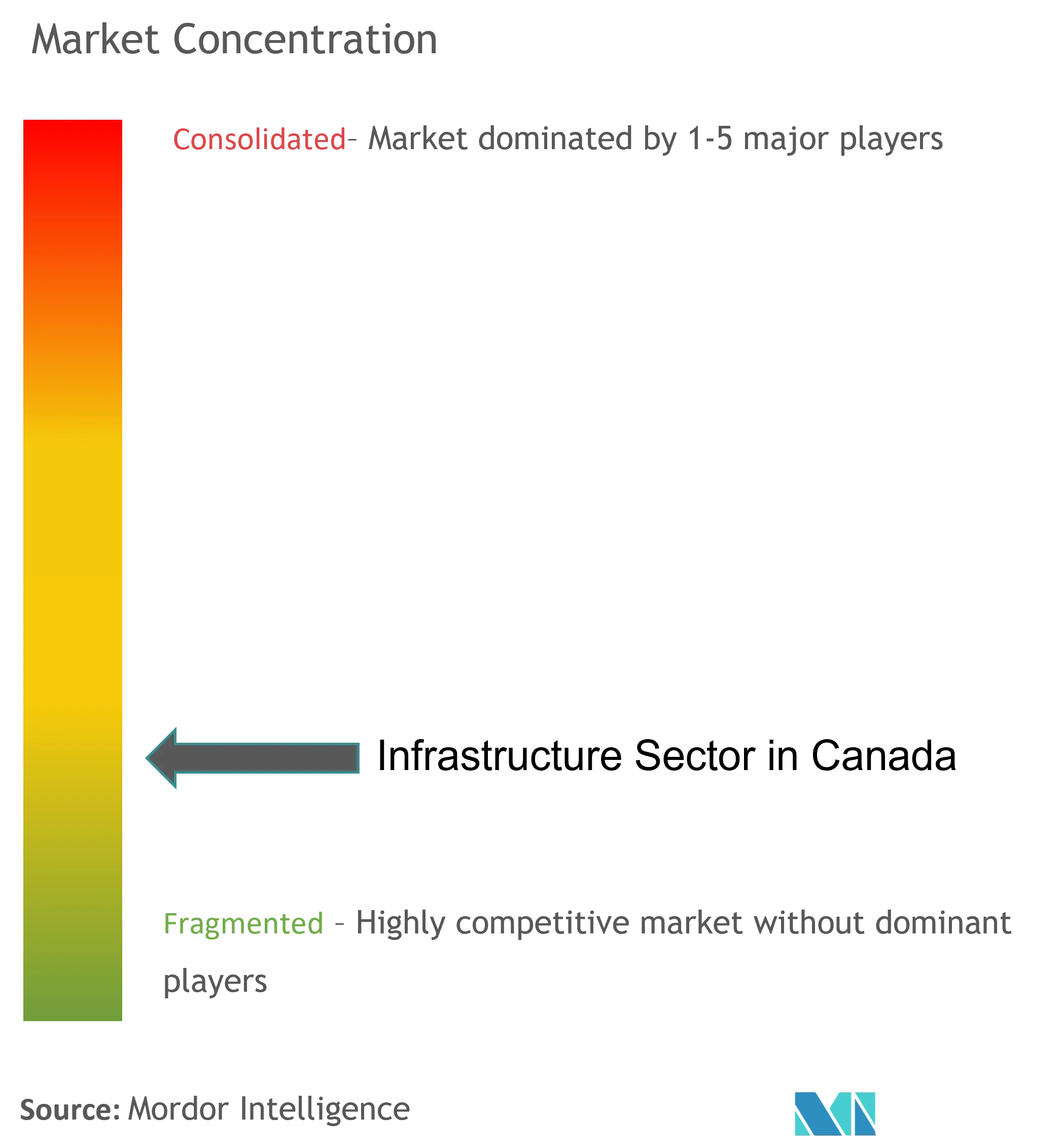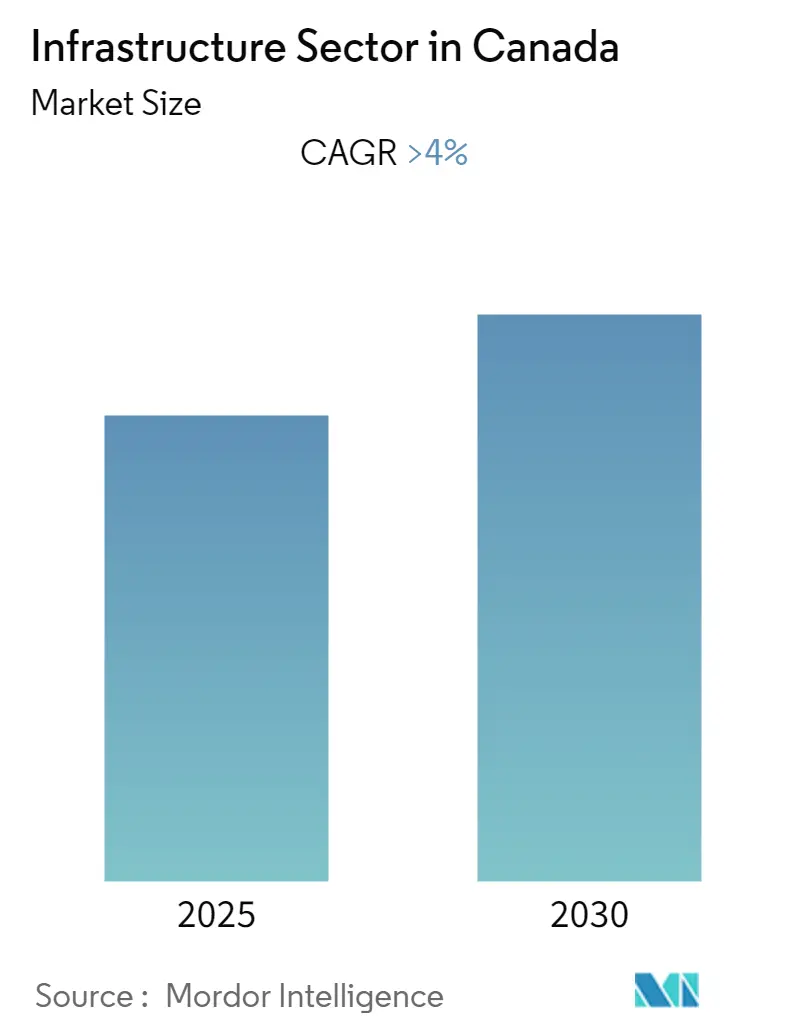
Canadian Infrastructure Market Analysis
The Infrastructure Sector in Canada Market is expected to register a CAGR of greater than 4% during the forecast period.
- Infrastructure is an important sector for any country's economic growth. The infrastructure market segments mainly include electricity, roads, water systems, public utilities, airports, railways, and telecommunications. The Canadian government's planned investments in infrastructure are expected to support the growth of Canada's construction industry.
- By the start of 2021, the Canadian government launched a USD 7.6 billion "Growth Plan" for Canada Infrastructure Bank (CIB) to create 60,000 jobs and support the country's post-COVID-19 economic recovery over the next three years through major investment projects.
- Under this "Growth Plan", USD 2 billion is earmarked for clean energy projects, USD 1.6 billion for broadband, USD 1.6 billion for building retrofits, USD 1.2 billion for agriculture irrigation projects, and USD 1.2 billion for electric buses and charging infrastructure.
- The government has adopted measures to attract more Foreign Direct Investment (FDI) into the country to boost tourism, both in terms of domestic travelers and large-scale international MICE events. This has also created more investment for airports and airport infrastructure.
- The National Housing Strategy of Canada has lofty goals to ensure that unprecedented investments and innovative programs provide results. The government's initial goal was to reduce chronic and episodic homelessness by half, but it is now focusing on eliminating chronic homelessness in Canada, with up to 530,000 households being lifted out of housing need.
- Up to 125,000 new housing units and 300,000 repaired or updated housing units will be created as a result of the National Housing Strategy. The National Housing Strategy will develop a new generation of housing in Canada through new initiatives such as the National Housing Co-Investment Fund, community housing programs, and support to provinces and territories. Our strategy will encourage a varied range of communities.
- Funding for the National Housing Co-Investment Fund of CAD 750 million (USD 598.03 million) is planned to be advanced to 2021-22 and 2022-23. This will speed up the production of 3,400 new units and the repair of 13,700 existing ones.
Canadian Infrastructure Market Trends
Growth in Transportation Infrastructure
The Airport Critical Infrastructure Program, first announced in the 2021 Fall Economic Statement, is part of a federal stimulus recovery plan aimed at building a stronger, more inclusive, and more resilient economy post-COVID-19.
Established in May 2021, the Airport Relief Fund provides CAD 64.8 Million (USD 4.71 Million) in financing for targeted airports, with 2019 sales of less than CAD 250 Million (USD 181 Million) in 2021-2022. The Airport Critical Facilities Program announced financing of CAD 81.6 Million (USD 59.3 Million) in August 2021 to help Canada's primary airports with investments in COVID-19 testing and screening infrastructure.
As Canada recovered from the COVID-19 pandemic, improvements in airport infrastructure are critical to ensuring the safety, security, and connectivity of travelers, employees, and communities.
The Ministry of Transportation announced more than CAD 5 Million (USD 3.6 Million) in new funding in February 2022 to assist the Fort McMurray International Airport in recovering from the effects of the COVID-19 pandemic and support ongoing air services and critical transportation infrastructure projects at the airport.
The Ministry of Transportation announced CAD 10.4 Million (USD 0.75 Million) in additional financing in February 2022 to assist the Edmonton International Airport in recovering from the COVID-19 pandemic's effects.
This funding comes on top of nearly CAD 18.5 Million (USD 13.4 Million) announced in July 2021 as part of the Airport Critical Infrastructure Program for infrastructure improvements such as runway and airfield lighting, as well as CAD 6.2 Million (USD 4.5 Million) from Transport Canada's Airport Relief Fund to help the airport maintain continued airport operations and essential air services for residents and workers in Edmonton and surrounding communities.
The Kelowna International Airport will receive more than CAD 18 million (USD 13 Million) in funding from the Ministry of Transportation in January 2022.
Nova Scotia's Five-Year Highway Renovation Plan comprises more than 150 major construction and improvement projects for the coming year, all of which will improve the safety of the province's roads, highways, and bridges.
In 2022-23, the government planned to spend almost CAD 500 Million (USD 363 Million) on motorways, bridges, and roads. According to the Alberta government, around CAD 1.5 Billion (USD 1.09 Billion) was invested in 172 projects during the 2021 construction season.
CAD 2.25 Billion (USD 1.63 Billion) in capital expenditure for road and bridge twinning, widening, and expansion planning, design, and construction. Highway and bridge rehabilitation and replacement projects cost CAD 1.5 Billion (USD 1.09 Billion) in capital maintenance and renewal.
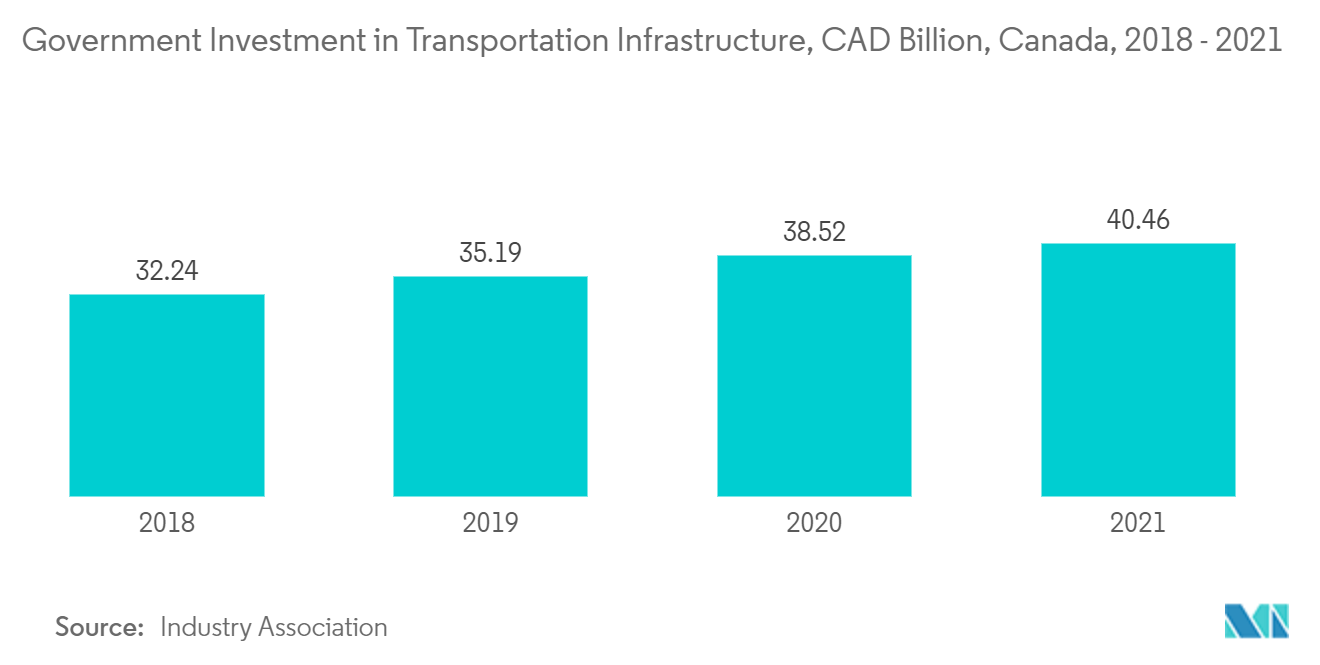
Increasing government's investment in Canada's infrastructure sector
Despite the obstacles of the pandemic, there is no shortage of large building projects, and high-value governmental and private sector projects continue to break ground at a steady pace. Major projects worth more than CAD 100 million (USD 79.74 million) includes Montreal's Bellechasse Transport Centre, Calgary's Complex Continuing Care Facility, and the new Brampton Transit Facility, to name a few.
Across the country, major construction projects are being planned. For example, under the Investing in Canada Infrastructure Program, the Canadian and Alberta governments have invested about USD 52.7 million in the completion of many infrastructure projects.
The Community Infrastructure Improvement Fund (CIIF) has set aside USD 150 million to repair and develop community infrastructure around the country. The Canadian government is eager to invest in significant infrastructure projects, and the stock market is optimistic.
CAD 704 million (USD 561.35 million) has been committed to 16 Air and 27 Maritime projects under the National Trade Corridors Fund, leveraging a total investment of CAD 1.45 billion (USD 1.16 billion); and CAD 1.09 billion (USD 0.87 billion) has been committed to 19 rail and 21 road projects, leveraging a total investment of CAD 2.5 billion (USD 1.99 billion).
The Ministry of Transport announced 29 new projects that will receive funding from the Enhanced Road Safety Transfer Payment Program in August 2021. The program will invest CAD 12.5 million (USD 9.97 million) in initiatives throughout Canada to improve vehicle safety and minimize collision risks, such as new tools to reduce drug-impaired driving, bicycle safety, new connected and automated vehicle sensors, and tools to reduce distracted driving and speeding.
Canadian Infrastructure Industry Overview
With numerous well-known Canadian infrastructure development companies, Canada's infrastructure market is competitive. The market is getting more competitive as the Canadian government encourages Foreign Direct Investment.
Significant investments and project development are directed toward critical commercial and manufacturing construction projects. Following the COVID-19 pandemic, the Canadian government increased its investment budget for building projects, making the entire infrastructure sector in the country more competitive for the critical firms involved.
Canadian Infrastructure Market Leaders
-
Aecon Group Inc.
-
PCL Construction
-
Pomerleau
-
Bird Construction
-
Bantrel
- *Disclaimer: Major Players sorted in no particular order
Canadian Infrastructure Market News
- September 2022: Canada's Enbridge acquired U.S.-based renewable energy developer Green Power Provider Tri Global for 270 Million dollars. The deal strengthens Enbridge's renewables portfolio, including offshore wind farms in Europe and solar projects supplying power to its oil and gas pipelines in North America.
- September 2022: WSP has completed the acquisition of the environmental and infrastructure (E&I) business of John Wood Group plc. This transaction will also enable us to seize opportunities in the fast-growing ecological and water sectors.
Canadian Infrastructure Industry Segmentation
The infrastructure of a country, society, or organization consists of basic facilities such as transport, communications, power supplies, and buildings, which enable it to function.
The infrastructure sector in Canada is segmented By Infrastructure Segment (Social Infrastructure, Transportation Infrastructure, Extraction Infrastructure, and Manufacturing Infrastructure). The report offers the market sizes and forecasts for the Infrastructure Sector in Canada market in value (USD) for all the above segments.
| By Infrastructure Segment | Social Infrastructure | Schools | |
| Hospitals | |||
| Defense | |||
| Other Social Infrastructures | |||
| Transportation Infrastructure | Railways | ||
| Roadways | |||
| Airport | |||
| Waterways | |||
| Extraction Infrastructure | Power Generation | ||
| Electricity Transmission and Distribution | |||
| Water | |||
| Gas | |||
| Telecom | |||
| Manufacturing Infrastructure | Metal and Ore Production | ||
| Petroleum Refining | |||
| Chemical Manufacturing | |||
| Industrial Parks and clusters | |||
| Other Manufacturing Infrastructures | |||
Canadian Infrastructure Market Research FAQs
What is the current Canada Infrastructure Market size?
The Canada Infrastructure Market is projected to register a CAGR of greater than 4% during the forecast period (2025-2030)
Who are the key players in Canada Infrastructure Market?
Aecon Group Inc., PCL Construction, Pomerleau, Bird Construction and Bantrel are the major companies operating in the Canada Infrastructure Market.
What years does this Canada Infrastructure Market cover?
The report covers the Canada Infrastructure Market historical market size for years: 2020, 2021, 2022, 2023 and 2024. The report also forecasts the Canada Infrastructure Market size for years: 2025, 2026, 2027, 2028, 2029 and 2030.
Our Best Selling Reports
Canadian Infrastructure Industry Report
Statistics for the 2025 Infrastructure Sector in Canada market share, size and revenue growth rate, created by Mordor Intelligence™ Industry Reports. Infrastructure Sector in Canada analysis includes a market forecast outlook for 2025 to 2030 and historical overview. Get a sample of this industry analysis as a free report PDF download.

